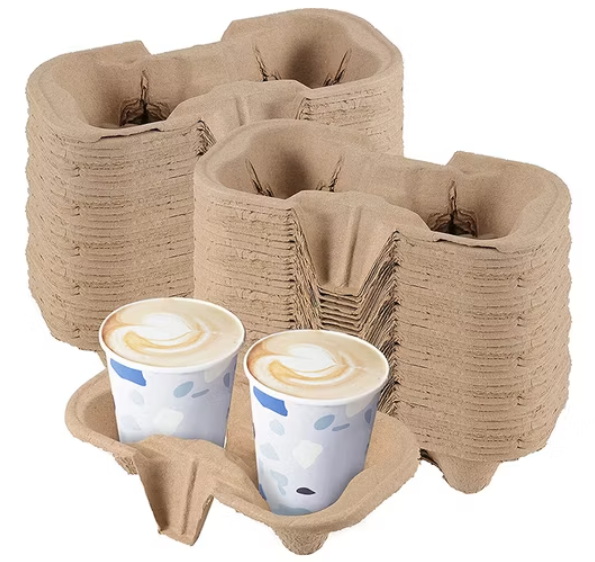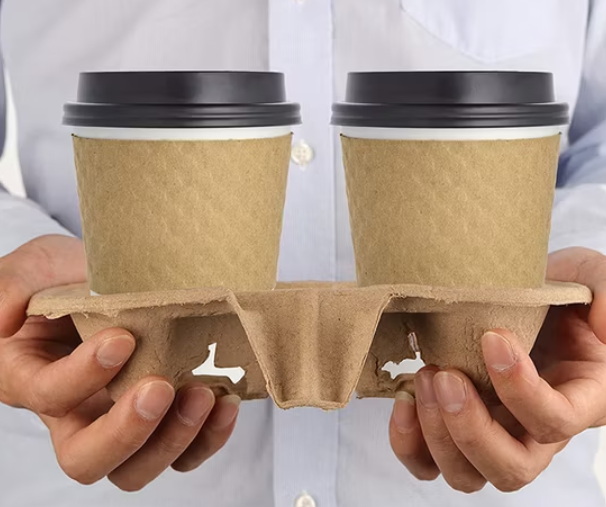
Content Menu
● Introduction to Disposable Cup Holders
>> Types of Materials
>>> 1. Pulp Fiber Material
>>> 2. Corrugated Cardboard
>>> 3. Plastic
>>> 4. Biodegradable Materials
● Environmental Considerations
>> Sustainable Practices
● Manufacturing Process
>> Manufacturing Pulp Fiber Cup Holders
>> Video: Pulp Fiber Manufacturing Process
● Cost-Effectiveness
>> Comparison of Costs
● Customization and Branding
>> Benefits of Customization
● Innovations in Materials
>> PLA Bioplastics
● Comparison with Other Materials
>> PET and HDPE Plastics
>> Biodegradable Alternatives
● Impact on the Coffee Industry
>> Case Study: Pulp Fiber in the Coffee Industry
● Conclusion
● FAQs
>> 1. What are the most environmentally friendly materials for disposable cup holders?
>> 2. How do pulp fiber cup holders compare to corrugated cardboard holders in terms of durability?
>> 3. What are the advantages of using plastic cup holders?
>> 4. How does the manufacturing process differ for pulp fiber and corrugated cardboard cup holders?
>> 5. What factors should be considered when choosing a disposable cup holder material?
● Citations:
Disposable cup holders are essential in the food and beverage industry, particularly for take-out and fast-food services. They provide stability and insulation for disposable cups, ensuring that beverages remain at the desired temperature while protecting consumers' hands from heat or cold. The choice of material for disposable cup holders significantly impacts their environmental sustainability, durability, and cost-effectiveness. In this article, we will explore the best materials for disposable cup holders, focusing on their characteristics, advantages, and environmental impact.

Introduction to Disposable Cup Holders
Disposable cup holders are designed to hold beverage containers securely, preventing spills and providing insulation. They are commonly used in fast-food restaurants, cafes, and other food establishments. The materials used for these holders vary, each offering unique benefits and drawbacks.
Types of Materials
1. Pulp Fiber Material
- Description: Pulp fiber cup holders are made from recycled paper or cardboard. They are biodegradable and compostable, making them an environmentally friendly option.
- Advantages: Lightweight, breathable, and suitable for cold drinks. They are also cost-effective and produce less pollution.
- Disadvantages: Less durable and may not be suitable for hot beverages or heavy cups.
2. Corrugated Cardboard
- Description: Corrugated cup holders are made from corrugated cardboard, offering greater durability and strength compared to pulp fiber holders.
- Advantages: Can carry heavier cups, more stable, and cost-effective.
- Disadvantages: Less environmentally friendly than pulp fiber due to higher material density.
3. Plastic
- Description: Plastic cup holders are durable and versatile but have significant environmental drawbacks.
- Advantages: Can be reused multiple times, resistant to moisture.
- Disadvantages: Contributes to plastic waste, not biodegradable.
4. Biodegradable Materials
- Description: Materials like bamboo, cornstarch, or recycled cardboard are used to create biodegradable cup holders. These materials break down naturally without harming the ecosystem.
- Advantages: Sustainable, lightweight, and safe for personal and commercial use.
- Disadvantages: May be more expensive than traditional materials.
Environmental Considerations
As environmental awareness grows, the demand for eco-friendly disposable cup holders has increased. Materials like pulp fiber and recycled cardboard are gaining popularity due to their biodegradable nature and lower carbon footprint.
Sustainable Practices
- Recyclable Materials: Using materials that can be recycled or composted reduces waste and supports a circular economy.
- Biodegradable Options: Pulp fiber and other biodegradable materials ensure that cup holders decompose naturally, minimizing environmental harm.
- Reduced Resource Use: Lightweight materials like pulp fiber require fewer resources for production and transportation, further reducing environmental impact.
Manufacturing Process
The manufacturing process for disposable cup holders varies depending on the material used. For pulp fiber holders, the process involves molding pulp into the desired shape, while corrugated cardboard holders are cut and folded from sheets of corrugated board.
Manufacturing Pulp Fiber Cup Holders
1. Material Collection: Collecting recycled paper or wood chips.
2. Pulping: Breaking down the material into pulp.
3. Molding: Shaping the pulp into cup holder forms.
4. Drying: Allowing the molded pulp to dry and harden.
Video: Pulp Fiber Manufacturing Process
The video demonstrates how pulp fiber is transformed into cup holders, showcasing the eco-friendly nature of this process.

Cost-Effectiveness
The cost of disposable cup holders is influenced by the material used and the production process. Pulp fiber and corrugated cardboard are generally more cost-effective than plastic due to lower material costs and simpler manufacturing processes.
Comparison of Costs
| Material | Cost per Unit | Environmental Impact |
| Pulp Fiber | Low | High Sustainability |
| Corrugated | Moderate | Moderate Sustainability |
| Plastic | High | Low Sustainability |
Customization and Branding
Disposable cup holders can be customized with logos, designs, and messages, making them an ideal marketing tool for businesses. This customization allows companies to promote their brand while providing customers with a sustainable accessory that is both practical and aesthetically pleasing.
Benefits of Customization
- Marketing Tool: Customized cup holders can increase brand visibility and customer engagement.
- Sustainability: Eco-friendly materials align with consumer preferences for sustainable products.
- Cost-Effectiveness: Customization does not significantly impact the final cost of the cup holder.
Innovations in Materials
Recent innovations include the use of bioplastics like PLA (Polylactic Acid), which is derived from renewable resources such as corn starch or sugarcane. PLA is biodegradable and compostable, offering a sustainable alternative to traditional plastics.
PLA Bioplastics
- Description: PLA is a bioplastic that can be composted along with food waste, reducing environmental impact.
- Advantages: Durable, suitable for hot and cold beverages, and compostable.
- Disadvantages: More expensive than traditional plastics.
Comparison with Other Materials
PET and HDPE Plastics
- PET Plastic: Known for its durability and resistance to heat, PET is commonly used for cold beverages. However, it is not biodegradable.
- HDPE Plastic: Offers strength and resistance to leaks, but also contributes to plastic waste.
Biodegradable Alternatives
- Bagasse Paper: Derived from sugarcane pulp, this material is biodegradable and compostable, offering a sustainable option for takeaway cups.
- Kraft Paper: Used in corrugated cardboard, kraft paper is durable and compostable, providing good insulation.
Impact on the Coffee Industry
The coffee industry is one of the largest consumers of disposable cup holders. By adopting sustainable materials like pulp fiber and biodegradable cardboard, coffee shops can significantly reduce their environmental footprint.
Case Study: Pulp Fiber in the Coffee Industry
Several coffee chains have successfully implemented pulp fiber cup holders, reducing waste and enhancing their brand image as environmentally conscious.
Conclusion
Choosing the best material for disposable cup holders involves balancing durability, cost, and environmental impact. Pulp fiber and corrugated cardboard offer sustainable alternatives to traditional plastic holders, providing a more eco-friendly option for businesses and consumers alike.

FAQs
1. What are the most environmentally friendly materials for disposable cup holders?
Pulp fiber and recycled cardboard are the most environmentally friendly materials for disposable cup holders due to their biodegradable nature and lower carbon footprint.
2. How do pulp fiber cup holders compare to corrugated cardboard holders in terms of durability?
Pulp fiber cup holders are less durable than corrugated cardboard holders, as they are more prone to moisture damage and have a weaker structure. However, they are more environmentally friendly.
3. What are the advantages of using plastic cup holders?
Plastic cup holders are durable and can be reused multiple times. They are also resistant to moisture, making them suitable for both hot and cold beverages.
4. How does the manufacturing process differ for pulp fiber and corrugated cardboard cup holders?
Pulp fiber cup holders are manufactured by molding pulp into the desired shape, while corrugated cardboard holders are cut and folded from sheets of corrugated board.
5. What factors should be considered when choosing a disposable cup holder material?
When choosing a material, consider factors such as environmental sustainability, durability, cost-effectiveness, and the type of beverage being served.
Citations:
[1] https://www.immould.com/types-of-plastic-cups/
[2] https://www.greenolives.com.cn/pulp-paper-cup-holders-sustainable-solution-coffee-industry/
[3] https://bioresources.cnr.ncsu.edu/resources/effect-of-material-properties-on-the-paper-cup-manufacturing-process/
[4] https://originalcupkeeper.com/blog/eco-friendly-cup-holder-for-carnaval/
[5] https://www.eco-pack.com/info/what-is-a-biodegradable-cup-holder-94884810.html
[6] https://newji.ai/japan-industry/manufacturing-process-of-cup-holders-for-cars-and-improvement-in-stability/
[7] https://mtpak.coffee/2023/06/sustainable-materials-takeaway-coffee-cups/
[8] https://www.ecocuplids.com/Industry-news/sustainable-eco-friendly-cup-holder.html
[9] https://www.kimecopak.ca/blogs/news/exploring-the-process-of-paper-cup-manufacturing
[10] https://www.webstaurantstore.com/guide/610/types-of-disposable-cups.html
[11] https://www.designboom.com/design/eco-friendly-paper-coffee-cups-holder-accordion-07-09-2024/
[12] https://patents.google.com/patent/US6652793B2/en
[13] https://retulp.com/2025-wetgeving-wegwerpplastics/
[14] https://simplyecopackaging.co.uk/product-range/drink-packaging/cup-holders/
[15] https://customcupfactory.com/blogs/news/how-are-plastic-cups-made-understanding-the-process-of-disposable-cup-production
[16] https://originalcupkeeper.com/blog/reusable-event-cups-comprehensive-guide/
[17] https://www.eco-greenergy.com/en/products/plastic-free-takeaway-wood-pulp-coffee-cup-holder
[18] https://mouldedpulpmachine.com/solutions/cup-carrier-tray/
[19] https://www.thebusinessresearchcompany.com/report/cups-and-lids-global-market-report
[20] https://luzhoupack.com/collections/biodegradable-coffee-cup-holders-paper

















